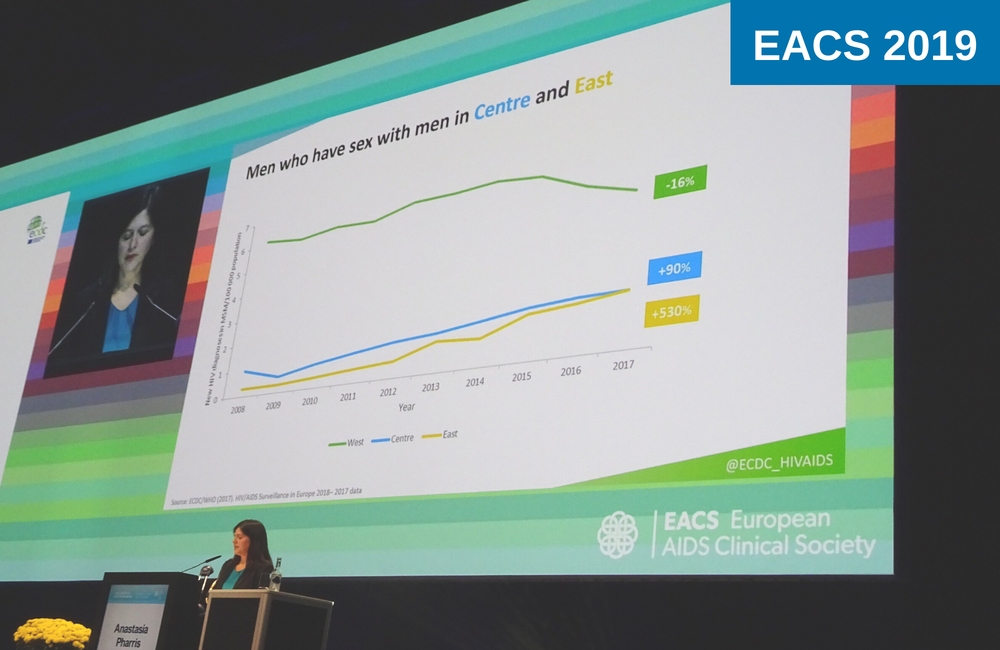
The 90-90-90 targets for HIV diagnosis, treatment and viral suppression will be missed in much of eastern Europe due to poor access to HIV treatment, the 17th European AIDS Conference (EACS 2019) heard on its opening day in Basel, Switzerland.
About 400 new HIV infections occur each day in the European region. “Part of the reason for the high rate of new infections is late diagnosis, but too many people are still not on treatment – about one million people living with HIV in the European region are not on treatment,” Anastasia Pharris of the European Centre for Disease Prevention and Control (ECDC) told a press conference.
“Only two in five people living with HIV have an undetectable viral load,” she said.
“We see a reduction in new HIV infections in men who have sex with men in some western European countries but an increase in infections in heterosexuals in eastern Europe,” said Professor Jens Lundgren of the University of Copenhagen, Denmark.
Whereas new HIV infections have fallen by 30% across western Europe since 2007, they have increased by 60% in eastern Europe. While half of new infections in western Europe occur in men who have sex with men, a quarter of infections in eastern Europe occur in people who inject drugs, a quarter in heterosexual men and a quarter in heterosexual women. The rate of growth has been sharpest in heterosexual men and women over the age of 30 in eastern Europe, where new infections have more than doubled since 2007.
ECDC estimates that 438,000 people with HIV remain undiagnosed in the European region and the median time from infection to diagnosis is 2.9 years. Late diagnosis remains a problem throughout the European region, not helped by stigmatisation of HIV, drug use and sexuality and the unwillingness of many people to identify themselves as drug users or gay.
Normalisation of HIV testing in general practice would help to overcome the stigmatisation of HIV.
“In Germany we have the barrier of the signed consent form,” said Professor Jurgen Rockstroh of the University of Bonn, Germany, co-chair of the conference. “Even in countries that have achieved the 90-90-90 goal we still have the problem of late presentation, and a lot of that begins with the stigmatisation of HIV testing in general practice.”
But diagnosing HIV infection depends on testing people who have the virus. “Across the continent we probably do enough HIV tests, they’re just not targeting the right people,” Jens Lundgren said. Better targeting of HIV testing resources towards key populations would improve the yield of testing, especially in countries with lower HIV prevalence.
How far is Europe from achieving the 90-90-90 targets?
Although late diagnosis is a challenge in Europe, overall rates of HIV diagnosis compare favourably with some other regions of the world. Overall, 80% of people living with HIV know their status, and more than half of European countries have already met, or are close to meeting, the target of 90% of people living with HIV diagnosed.
But for the second 90, a major gap has opened between western and eastern Europe. “The target will be missed in much of Eastern Europe,” said Anastasia Pharris. Across the region, 65% of people diagnosed with HIV are on antiretroviral treatment. Since 2015, 440,000 people have started treatment but one million people living with HIV remain untreated. Linkage to care after diagnosis is slow in eastern Europe.
As for the third 90, although 86% of people on treatment across the region are virally suppressed, due to the treatment gap, 1.2 million people are still living with unsuppressed HIV. In the 36 countries of the European region that can measure their treatment continuum of care fully, viral suppression among all people living with HIV is 44%. As a result, HIV incidence is not falling.
There are major disparities for key populations. Whereas 87% of men who have sex with men are diagnosed, 77% are on treatment and 70% are virally suppressed in the countries able to report, results are poorer for people who inject drugs. Although 90% of people who inject drugs and living with HIV are diagnosed, only 50% are on treatment and only 39% are virally suppressed.
What needs to change?
Both western and eastern Europe need to address the prevention gap – the low levels of PrEP provision, inadequate harm reduction coverage for people who inject drugs and the lack of condom provision – while eastern Europe also needs to address low antiretroviral therapy coverage if the region is to achieve the 90-90-90 targets, Anastasia Pharris concluded.
Although PrEP coverage is growing – “two years ago only one country had PrEP, now there are 17,” said Jens Lundgren – focusing on one or two prevention options is insufficient, Professor Lundgren told the conference.
Modelling by the Swiss HIV Cohort Study published in 2018 found that a combination of measures – doubling the diagnosis rate, providing PrEP and a 'test and treat' policy – would probably have the greatest impact on HIV incidence in Switzerland.
The speed of response and the maintenance of a response are also critical, Lundgren pointed out. A second modelling exercise by the same group found that the speed of introduction of harm reduction in Switzerland in the early 1990s and its maintenance throughout the epidemic had significant effects on the size of the HIV epidemic in people who inject drugs and the general population. If harm reduction had been introduced two years earlier, it would have halved the epidemic, the Swiss researchers estimated.
Outbreaks of HIV among people who inject drugs in Athens and Romania, as well as the impact of war in Ukraine on the movement of people who inject drugs, show the fragility of HIV control in the face of financial crisis and political turmoil.
